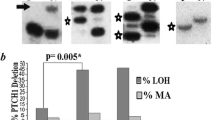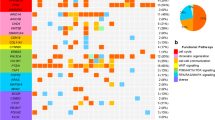Abstract
Purpose
To evaluate the frequency of ERBB2, INT2 and CMYC oncogene amplifications and their coexistence with PTEN gene mutations in endometrial carcinomas.
Methods
In 54 endometrial carcinomas amplification of ERBB2, INT2 and CMYC was determined using differential polymerase chain reaction (dPCR), and mutations in all exons of PTEN were investigated by PCR-SSCP and direct sequencing methods. Results were correlated with clinicopathological features of tumors.
Results
In 31 out of 54 endometrial carcinomas (57.4%) genetic defects were found within the examined genes. Of all identified defects, mutations in PTEN and the amplification of CMYC were most frequent (26/54–48.1% and 10/54–18.5%, respectively). INT2 was amplified in 5.6% (3/54) of cases. In no case did we find ERBB2 amplification. In 77.4% (24/31) of cases only one gene was damaged. Of these, 20 cases showed only PTEN mutations, three cases only CMYC, and one case only INT2 amplification. In another seven out of 31 tumors (22.5%) defects in two or three genes coexisted simultaneously: PTEN and CMYC in five cases, CMYC and INT2 in one case, and PTEN, CMYC, and INT2 in one case. We found a number of interesting relations between the location of mutations within the PTEN sequence and the presence (+) or lack (-) of CMYC amplification. In the PTEN+CMYC- tumors the PTEN mutations were most frequent in exons 1–5, and less frequent in exons 7–8 (66.7% and 33.3%, respectively). In contrast, in the PTEN+CMYC+ carcinomas the PTEN mutations were found mainly in exons 7–8 (85.7%). PTEN mutations were equally frequent in both early and more advanced endometrial carcinomas. The CMYC amplification, however, was more frequent in advanced as compared to early tumors, although this difference did not reach statistical significance.
Conclusions
Our data suggest that differences in the presence of genetic defects may reflect the different molecular pathways of endometrial carcinogenesis. These data also suggest that location of intragenic PTEN mutations and their coexistence with the CMYC amplification may play a crucial part in the development of various subtypes of endometrial carcinoma, but this preliminary suggestion requires further research.

Similar content being viewed by others
References
Ali Lu, Shriml LM, Dean M (1999) Mutational spectra of PTEN/MMAC1 gene tumor suppressor with lipid phosphatase activity. J Natl Cancer Inst 91:1922–1932
Amundadottir LT, Merlino G, Dickson RB (1996) Transgenic mouse model of breast cancer. Breast Cancer Res Treat 39:119–135
Beckmann MW, Niederacher D, Köhrer K, Finken-Eigen M, Schröder W, Schnurch G, Bender HG (1996) Oncogene amplification in archival ovarian carcinoma detected by fluorescent differential polymerase chain reaction-a routine analytical approach. Int J Gynecol Cancer 6:291–297
Berns EM, Foekens JA, van Staveren IL, van Putten WL, de Koning HG, Portengen H, Klijn JG (1995) Oncogene amplification and prognosis in breast cancer: relationship with systemic treatment. Gene 159:11–18
Bokhman JV (1983) Two pathogenetic types of endometrial carcinoma. Gynecol Oncol 15:10–17
Borst MP, Baker VV, Dixon D, Hatch KD, Shingleton HM, Miller DM (1990) Oncogene alterations in endometrial carcinoma. Gynecol Oncol 38:364–366
Bussaglia E, del Rio E, Matias-Guiu J, Prat J (2000) PTEN mutations in endometrial carcinoma: a molecular clinicopathologic analysis of 38 cases. Hum Pathol 31:312–317
Creasman WT (1989) FIGO stages:1988 revisions. Gynecol Oncol 35:125–127
Esteller M, Garcia A, Martinez-Palones JM, Cabero A, Reventos J (1995) Detection of C-erb-2/neu and fibroblast growth factor-3/INT-2 not epidermal growth factor receptor gene amplification in endometrial cancer by differential polymerase chain reaction. Cancer 75:2139–2146
Frye RA, Benz C, Lin E (1989) Detection of oncogenes by differential polymerase chain reaction. Oncogene 4:1153–1157
Ghosh AK, Grigorieva I, Steele R, Hoover RG, Ray RB (1999) PTEN transcriptionally modulates c-myc gene expression in human breast carcinoma cells and is involved in cell growth regulation. Gene 235:85–91
Han SY, Kato H, Kato S, Suzuki T, Shibata H, Ishii S, Shiiba K, Matsuno S, Kanamura R, Ishioka Ch (2000) Funcional evaluation of PTEN missense mutation using in vitro phosphoinositide phosphatase assay. Cancer Res 60:3147–3151
Horowitz N, Pinto K, Mutch DG, Herzog TJ, Rader JS, Gibb R, Bocker-Edmonston T, Goodfellow PJ (2002) Microsatellite instability, MLH1 promoter methylation, and loss of mismatch repair in endometrial cancer and concominant atypical hyperplasia. Gynecol Oncol 86:62–68
Hruza C, Dobianer K, Beck A, Czerwenka K, Hanak H, Klein M, Leodolter S, Medl M, Müllauer-Ertl S, Preiser J, Rosen A, Salzel H, Selveda P, Spona J (1993) Her-2 and INT-2 amplification estimated by quantitative PCR in paraffin-embedded ovarian cancer tissue samples. Eur J Cancer 29A:1593–1597
Inoue M (2001) Current molecular aspects of carcinogenesis of the uterine endometrium. Int J Gynecol Cancer 11:339–348
Konopka B, Paszko Z, Janiec-Jankowska A, Goluda M (2002) Assessment of the quality and frequency of mutations occurrence in PTEN gene in endometrial carcinomas and hyperplasias. Cancer Lett 178:43–51
Koul A, Willen R, Bendahl P-O, Nilbert M, Borg A (2002) Distinct sets of gene alterations in endometrial carcinoma implicate alternate modes of tumorigenesis. Cancer 94:2369–2379
Latta E, Chapman WB (2002) PTEN mutations and evolving concepts in endometrial neoplasia. Curr Opin Obstet Gynecol 14:59–65
Lax SF, Kendal B, Tashiro H, Slebas RJ, Ellenson LH (2000) The frequency of p53, K-ras mutation, and microsatellite instability differs in uterine endometrioid and serous carcinoma. Cancer 88:814–824
Lilja JF, Wu D, Reynolds RK, Lin J (2001) Growth suppression activity of the PTEN tumor -suppressor gene in human endometrial cancer cells. Anticancer Res 21:1969–1974
Machin P, Catacus L, Pons C, Munoz J, Matias-Guiu X, Prat J (2002) CTNNB1 mutations and beta-catenin expression in endometrial carcinomas. Hum Pathol 33:206–212
Manavi M, Bauer M, Baghestanian M, Berger A, Kucera E, Pischinger K, Battistutti W, Czerwenka K (2001) Oncogenic potential of c-erbB2 and its association with c-K-ras in premalignant and malignant lesions of the human uterine endometrium. Tumor Biol 22:299–309
Matias-Guiu X, Catacus L, Bussaglia E, Lagarda H, Garcia A, Pons C, Munoz J, Arguelles R, Machin P, Prat J (2001) Molecular pathology of endometrial hyperplasia and carcinoma. Hum Pathol 32:569–577
Menard S, Balsari A, Casalini P, Tagliabue E, Campiglio M, Bufalino R, Cascinelli N (2002) HER-2-positive breast carcinomas as a particular subset with peculiar clinical behaviors. Clin Cancer Res 8:520–525
Minaguchi T, Yoshikawa H, Oda K, Ishino T, Yasugi T, Onda T, Nakagawa S, Matsumoto K, Kawana K, Aketani Y (2001) PTEN mutation located only outside exons 5, 6, and 7 is an independent predictor of favorable survival in endometrial carcinomas. Clin Cancer Res 7:2636–2642
Monk BJ, Chapman JA, Johnson GA, Brightman BK, Wilczynski SP, Schell MJ, Fan H (1994) Correlation of C-myc and HER-2/neu amplification and expression with histopathologic variables in uterine corpus cancer. Am J Obstet Gynecol 171:1193–1198
Munger K (2002) Disruption of oncogene/tumor suppressor networks during human carcinogenesis. Cancer Invest 20:71–81
Mutter GL (2002) Diagnosis of premalignant endometrial disease. J Clin Pathol 55:326–331
Niederacher D, An H-X, Cho Y-J, Hantschmann P, Bender HG, Beckmann MW (1995) Mutations and amplification of oncogenes in endometrial cancer. Oncology 56:59–65
Pauley RJ, Gimotty PA, Paine TJ, Dawson PJ, Wolman SR (1996) INT2 and ERBB2 amplification and ERBB2 expression in breast tumors from patients with different outcomes. Breast Cancer Res Treat 37:65–76
Risinger JI, Hayes AK, Maxwell GL, Corney ME, Dodge RK, Barret JC, Berchuck A (1998) PTEN mutations in endometrial cancer is associated with favorable clinical and pathologic characteristics. Clin Cancer Res 4:3005–3010
Rolitsky CD, Theil KS, McGaughy VR, Copeland LJ, Niemann TH (1999) HER-2/neu amplification and overexpression in endometrial carcinoma. Int J Gynecol Pathol 18:138–143
Sakuragi N, Hirai A, Tada M, Yamada H, Yamamoto R, Fujimoto S, Moriuchi T (2001) Dominant-negative mutation of p53 tumor suppressor gene in endometrial carcinoma. Gynecol Oncol 83:485–490
Salvesen HB and Akslen A (2002) Molecular pathogenesis and prognostic factors in endometrial carcinoma. APMIS 110:673–689
Sambrook J, Fritsh EF, Maniatis T (1989) Molecular cloning: a laboratory manual, 2nd edn. Cold Spring Harbor Laboratory, Cold Spring Harbor, NY
Schraml P, Kononen J, Bubendorf L, Moch H, Bissig H, Nocito A, Michatsch MJ, Kallioniemi O-P, Sauter G (1999) Tissue microarrays for gene amplification surveys in many different tumor types. Clin Cancer Res 5:1966–1975
Scully RE, Bonfiglio TA, Kurman RJ, Silverberg SG, Wilkinson EJ (1994) Histological typing of female genital tract tumors. In: WHO: International histologocal typing of tumors. Springer, New York, pp. 14–31
Sherman ME (2000) Theories of endometrial carcinogenesis: a multidisciplinary approach. Mod Pathol 13:295–308
Tashiro H, Blazes MS, Wu R, Cho KR, Bose S (1997) Mutations in PTEN are frequent in endometrial carcinoma but rare in other common gynecological malignancies. Cancer Res 57:3935–3940
Van Nostrand K, Johnson G, Monk B, Wilczynski S, Chapman J, Brightman K, Schells M, Berman M, Manetta A, Disala P, Fan H (1998) Genetic alterations in endometrial carcinomas. Int J Gynecol Cancer 8:415–422
Williams JA Jr, Wang ZR, Parrish RS, Hazlett LJ, Smith ST, Young SR (1999) Fluorescence in situ hybridization analysis of HER-2/neu, c-myc, and p53 in endometrial cancer. Exp Mol Pathol 67:135–143
Author information
Authors and Affiliations
Corresponding author
Rights and permissions
About this article
Cite this article
Konopka, B., Janiec-Jankowska, A., Paszko, Z. et al. The coexistence of ERBB2, INT2, and CMYC oncogene amplifications and PTEN gene mutations in endometrial carcinoma. J Cancer Res Clin Oncol 130, 114–121 (2004). https://doi.org/10.1007/s00432-003-0518-7
Received:
Accepted:
Published:
Issue Date:
DOI: https://doi.org/10.1007/s00432-003-0518-7




